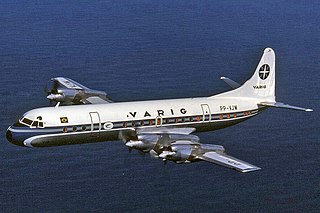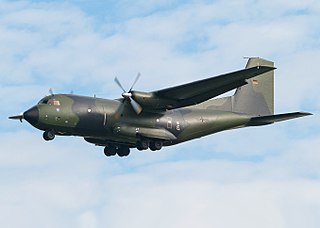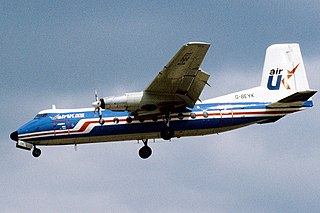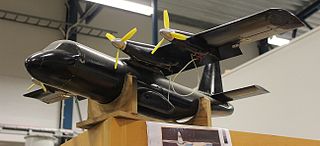Related Research Articles

The Airspeed AS.57 Ambassador is a British twin piston-engined airliner that was designed and produced by the British aircraft manufacturer Airspeed Ltd. It was one of the first postwar airliners to be produced.

The Ilyushin Il-18 is a large turboprop airliner that first flew in 1957 and became one of the best known and most durable Soviet aircraft of its era. The Il-18 was one of the world's principal airliners for several decades and was widely exported. Due to the aircraft's airframe durability, many examples achieved over 45,000 flight hours and the type remains operational in both military and civilian capacities. The Il-18's successor was the long range Il-62 jet airliner.
Hamburger Flugzeugbau (HFB) was an aircraft manufacturer, located primarily in the Finkenwerder quarter of Hamburg, Germany. Established in 1933 as an offshoot of Blohm & Voss shipbuilders, it later became an operating division within its parent company and was known as Abteilung Flugzeugbau der Schiffswerft Blohm & Voss from 1937 until it ceased operation at the end of World War II. In the postwar period it was revived as an independent company under its original name and subsequently joined several consortia before being merged to form Messerschmitt-Bölkow-Blohm (MBB). It participates in the present day Airbus and European aerospace programs.

The HFB 320 Hansa Jet is a twin-engine, ten-seat business jet that was designed and produced by German aircraft manufacturer Hamburger Flugzeugbau between 1964 and 1973. The most recognisable and unconventional feature of the aircraft is its forward-swept wing.

The Blohm & Voss BV 138Seedrache, but nicknamed Der Fliegende Holzschuh was a World War II German trimotor flying boat that served as the Luftwaffe's main seaborne long-range maritime patrol and naval reconnaissance aircraft.

The Lockheed L-188 Electra is an American turboprop airliner built by Lockheed. First flown in 1957, it was the first large turboprop airliner built in the United States. Initial sales were good, but after two fatal crashes that led to expensive modifications to fix a design defect, no more were ordered. With its unique high power-to-weight ratio, huge propellers and very short wings, large Fowler flaps which significantly increased effective wing area when extended, and four-engined design, the airplane had airfield performance capabilities unmatched by many jet transport aircraft even today—particularly on short runways and high field elevations. Jet airliners soon supplanted turboprops for many purposes, and many Electras were modified as freighters. Some Electras are still being used in various roles into the 21st century. The airframe was also used as the basis for the Lockheed P-3 Orion maritime patrol aircraft.

The Transall C-160 is a military transport aircraft, produced as a joint venture between France and Germany. "Transall" is an abbreviation of the manufacturing consortium Transporter Allianz, comprising the companies of MBB, Aerospatiale, and VFW-Fokker. It was initially developed to meet the requirements for a modern transport aircraft for the French and German Air Forces; export sales were also made to South Africa and to Turkey, as well as a small number to civilian operators.

The Fairey Rotodyne was a 1950s British compound gyroplane designed and built by Fairey Aviation and intended for commercial and military uses. A development of the earlier Gyrodyne, which had established a world helicopter speed record, the Rotodyne featured a tip-jet-powered rotor that burned a mixture of fuel and compressed air bled from two wing-mounted Napier Eland turboprops. The rotor was driven for vertical takeoffs, landings and hovering, as well as low-speed translational flight, but autorotated during cruise flight with all engine power applied to two propellers.

The Bréguet Br 960 Vultur was a prototype two-seat carrier-based attack and anti-submarine aircraft (ASW) built for the French Navy during the early 1950s. Meeting contradictory endurance and speed requirements, it was designed as a "mixed-power" aircraft with a turboprop engine in the front and a turbojet in the rear. Only two examples were built, but the second aircraft was rebuilt as the prototype of the Bréguet 1050 Alizé ASW aircraft after the Navy dropped the idea of a turboprop attack aircraft in the mid-1950s.

The Canadair CL-66 was a turboprop version of the civilian Convair CV-440 Metropolitan. The CC-109 Cosmopolitan or "Cosmo" in RCAF service became the standard VIP aircraft as well as replacing the Douglas Dakota and the North American B-25 Mitchell in light transport duties. After a lengthy career stretching into the 1990s, the CC-109 was replaced by the CC-142 Dash 8 and CC-144 Challenger.

The Handley Page Dart Herald is a 1950s British turboprop passenger aircraft.

The Beechcraft Model 99 is a civilian aircraft produced by Beechcraft. It is also known as the Beech 99 Airliner and the Commuter 99. The 99 is a twin-engine, unpressurized, 15 to 17 passenger seat turboprop aircraft, derived from the earlier Beechcraft King Air and Queen Air. It uses the wings of the Queen Air, the engines and nacelles of the King Air, and sub-systems from both, with a specifically designed nose structure.
Transall was a consortium created to design and manufacture the Transall C-160 military transport aircraft.

The CASA C-207 Azor was a transport aircraft produced by Construcciones Aeronáuticas SA (CASA). It was a scaled-up version of the CASA C-202 Halcón and was designed for the domestic civil market. The C-207 received no civil orders, but the Spanish Air Force ordered ten. The first model, designated T.7A entered service in 1960. Ten more aircraft were ordered and configured for paratroop or cargo transport, designated CASA 207C(T.7B). The CASA 207 was one of the first aircraft to be designed by CASA in order to replace the transports in current service at the time, like the CASA 2.111 and the CASA 352.

The CASA C-201 Alcotán ("Kestrel") was a 1950s transport aircraft, built by CASA for the Spanish Air Force.

The Commuter Aircraft Corporation CAC-100 was a 50–60 seat, four-engined, turboprop commuter airliner developed in the United States in the late 1970s and early 1980s.

The CASA 3000 was a proposed turboprop aircraft aimed at the regional airliner market. The project was proposed by Construcciones Aeronáuticas SA (CASA) during the early part of the 1990s.

The Tupolev Tu-116 is a turboprop-powered long-range airliner designed by the Tupolev design bureau and built in the USSR.

The Saab 107 was a proposed series of small airliners that were intended to be manufactured by Saab AB of Sweden, but were never built.
The Hamburger Flugzeugbau HFB 314 was a postwar design project for a twin-turbojet medium-range transport. It was cancelled when the German government decided to fund only international collaborations.
References
- ↑ Les Ailes, No. 1,642, 20 July 1957. (French)
- ↑ "Hamburger Flugzeugbau", Flight, 19 October 1961, pp.619-20
- ↑ "Vergessenes Projekt der 50er Jahre - Der Turboprop-Airliner HFB-209", Klassiker der Luftfahrt, 14 January 2014. (German)
- ↑ "Civil Aviation: A New West German Turboprop", Flight 19 July 1957, p.93